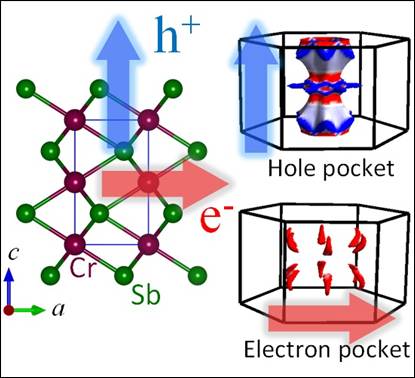Duality discovered in magnetic material could revolutionize design of electronic devices
Duality discovered in magnetic material could revolutionize design of electronic devices
Researchers have detected a striking novel behaviour in a class of magnetic material known as altermagnets that could one day revolutionize how we design electronic devices.
Magnets are a part of our day-to-day lives and play a crucial role in many of the devices we use. Scientists are on the lookout for the discovery of new classes of magnetic materials to improve the functioning of such devices. Altermagnets are a newly discovered class of magnetic materials that enjoy the best properties of both ferromagnets and antiferromagnets. Unlike regular magnets (ferromagnets), which you can stick to your fridge, or antiferromagnets, which cancel out their own magnetism, altermagnets do not show any net magnetism externally, but deep inside, their electrons behave in ways that can be incredibly useful—especially for futuristic technologies like spintronics (manipulating the spin of electrons instead of their charge).
Among the known altermagnets, chromium antimonide (CrSb) is truly remarkable. It is metallic, with the magnetic order sustaining up to more than two times that of room temperature and the largest altermagnetic spin-splitting, equivalent to more than 30 times that of room temperature. These outstanding attributes make CrSb the most promising altermagnetic candidate for practical applications.
Scientists from the S N Bose National Centre for Basic Sciences (SNBNCBS), an autonomous institution of the Department of Science and Technology (DST), have spotted a fascinating and previously unobserved electrical and thermal transport phenomenon in the high-quality single-crystalline altermagnet CrSb. They found that CrSb changes its identity based on direction. When electric current moves within the layers of the crystal (similar to flowing along the pages of a book), it is carried by electrons (typical of n-type materials). But when current is sent across the layers (like flipping through the pages), holes (the absence of electrons) take over (a trait of p-type materials).

Fig: The electrical conduction in altermagnet CrSb occurs through holes and electrons along the long and the short axis, respectively.
This direction-dependent conduction polarity (DDCP) is incredibly rare in solids and challenges the traditional classification of materials as either p-type or n-type, opening up new possibilities for the study of materials.
CrSb is one of the very few materials known to exhibit this property and, notably, the first Altermagnet to do so. This dual character opens exciting opportunities in the area of materials for next-generation devices.
Most devices — from solar cells to thermoelectrics — need both p-type and n-type materials to function. Traditionally, engineers achieve this by mixing different materials or doping a crystal with foreign elements. But CrSb does it all by itself. This could simplify devices and make them more compact, efficient, and easier to manufacture. The research published in the journal Advanced Science could obviate the need for heterostructures or doping gradients, significantly simplifying device architectures.
CrSb is made of earth-abundant and non-toxic elements, making it an environmentally friendly option for future electronics. Combined with its altermagnetic properties, CrSb could become a cornerstone of next-generation spintronic devices, offering both conduction versatility and magnetic control in one package.